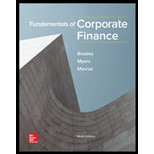
Fundamentals of Corporate Finance (Mcgraw-hill/Irwin Series in Finance, Insurance, and Real Estate)
9th Edition
ISBN: 9781259722615
Author: Richard A Brealey, Stewart C Myers, Alan J. Marcus Professor
Publisher: McGraw-Hill Education
expand_more
expand_more
format_list_bulleted
Question
Chapter 4, Problem 21QP
a)
Summary Introduction
To determine: The company with higher ratio.
b)
Summary Introduction
To determine: The company with higher ratio
c)
Summary Introduction
To determine: The company with higher ratio
d)
Summary Introduction
To determine: The company with higher ratio
Expert Solution & Answer
Want to see the full answer?
Check out a sample textbook solution
Students have asked these similar questions
Please don't use hand rating
"Dividend paying stocks cannot be growth stocks" Do you agree or disagree? Discuss choosing two stocks to help justify your view.
"Dividend paying stocks cannot be growth stocks" Do you agree or disagree? Discuss choosing two stocks to help justify your view.
Chapter 4 Solutions
Fundamentals of Corporate Finance (Mcgraw-hill/Irwin Series in Finance, Insurance, and Real Estate)
Ch. 4 - Market Value Added. Here is a simplified balance...Ch. 4 - Market Value Added. Suppose the broad stock market...Ch. 4 - Measuring Performance. Here are simplified...Ch. 4 - Measuring Performance. Recalculate Home Depot’s...Ch. 4 - Economic Value Added. EVA will be positive...Ch. 4 - Prob. 6QPCh. 4 - Financial Ratios. Here are simplified financial...Ch. 4 - Financial Ratios. Consider this simplified balance...Ch. 4 - Receivables. Chik’s Chickens has accounts...Ch. 4 - Inventory. Salad Daze maintains an inventory of...
Ch. 4 - Times Interest Earned. In the past year, TVG had...Ch. 4 - Leverage Ratios. Lever Age pays an 8% rate of...Ch. 4 - Prob. 13QPCh. 4 - Prob. 14QPCh. 4 - Inventory Turnover.
If a firm’s inventory level of...Ch. 4 - Leverage. A firm has a long-term debt–equity ratio...Ch. 4 - Leverage Ratios. A firm has a debt-to-equity ratio...Ch. 4 - Liquidity Ratios. A firm uses $1 million in cash...Ch. 4 - Prob. 19QPCh. 4 - Prob. 20QPCh. 4 - Prob. 21QPCh. 4 - Du Pont Analysis. Last year Electric Autos had...Ch. 4 - Du Pont Analysis. Torrid Romance Publishers has...Ch. 4 - Du Pont Analysis. Keller Cosmetics maintains an...Ch. 4 - Interpreting Financial Ratios. CFA Corp. has a...Ch. 4 - Using Financial Ratios. For each category of...
Knowledge Booster
Learn more about
Need a deep-dive on the concept behind this application? Look no further. Learn more about this topic, finance and related others by exploring similar questions and additional content below.Similar questions
- A firm needs to raise $950,000 but will incur flotation costs of 5%. How much will it pay in flotation costs? Multiple choice question. $55,500 $50,000 $47,500 $55,000arrow_forwardWhile determining the appropriate discount rate, if a firm uses a weighted average cost of capital that is unique to a particular project, it is using the Blank______. Multiple choice question. pure play approach economic value added method subjective approach security market line approacharrow_forwardWhen a company's interest payment Blank______, the company's tax bill Blank______. Multiple choice question. stays the same; increases decreases; decreases increases; decreases increases; increasesarrow_forward
- For the calculation of equity weights, the Blank______ value is used. Multiple choice question. historical average book marketarrow_forwardA firm needs to raise $950,000 but will incur flotation costs of 5%. How much will it pay in flotation costs? Multiple choice question. $50,000 $55,000 $55,500 $47,500arrow_forwardQuestion Mode Multiple Choice Question The issuance costs of new securities are referred to as Blank______ costs. Multiple choice question. exorbitant flotation sunk reparationarrow_forward
- What will happen to a company's tax bill if interest expense is deducted? Multiple choice question. The company's tax bill will increase. The company's tax bill will decrease. The company's tax bill will not be affected. The company's tax bill for the next year will be affected.arrow_forwardThe total market value of a firm is calculated as Blank______. Multiple choice question. the number of shares times the average price the number of shares times the future price the number of shares times the share price the number of shares times the issue pricearrow_forwardAccording the to the Blank______ approach for project evaluation, all proposed projects are placed into several risk categories. Multiple choice question. pure play divisional WACC subjectivearrow_forward
- To invest in a project, a company needs $50 million. Given its flotation costs of 7%, how much does the company need to raise? Multiple choice question. $53.76 million $46.50 million $50.00 million $53.50 millionarrow_forwardWhile determining the appropriate discount rate, if a firm uses a weighted average cost of capital that is unique to a particular project, it is using the Blank______. Multiple choice question. economic value added method pure play approach subjective approach security market line approacharrow_forwardWhat are flotation costs? Multiple choice question. They are the costs incurred to issue new securities in the market. They are the costs incurred to insure the payment due to bondholders. They are the costs incurred to meet day to day expenses. They are the costs incurred to keep a project in the business.arrow_forward
arrow_back_ios
SEE MORE QUESTIONS
arrow_forward_ios
Recommended textbooks for you
 Managerial Accounting: The Cornerstone of Busines...AccountingISBN:9781337115773Author:Maryanne M. Mowen, Don R. Hansen, Dan L. HeitgerPublisher:Cengage Learning
Managerial Accounting: The Cornerstone of Busines...AccountingISBN:9781337115773Author:Maryanne M. Mowen, Don R. Hansen, Dan L. HeitgerPublisher:Cengage Learning Financial Accounting: The Impact on Decision Make...AccountingISBN:9781305654174Author:Gary A. Porter, Curtis L. NortonPublisher:Cengage Learning
Financial Accounting: The Impact on Decision Make...AccountingISBN:9781305654174Author:Gary A. Porter, Curtis L. NortonPublisher:Cengage Learning


Managerial Accounting: The Cornerstone of Busines...
Accounting
ISBN:9781337115773
Author:Maryanne M. Mowen, Don R. Hansen, Dan L. Heitger
Publisher:Cengage Learning


Financial Accounting: The Impact on Decision Make...
Accounting
ISBN:9781305654174
Author:Gary A. Porter, Curtis L. Norton
Publisher:Cengage Learning
Financial ratio analysis; Author: The Finance Storyteller;https://www.youtube.com/watch?v=MTq7HuvoGck;License: Standard Youtube License